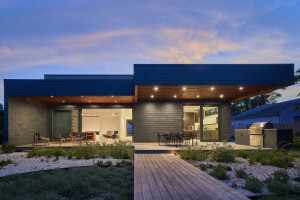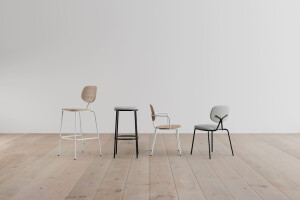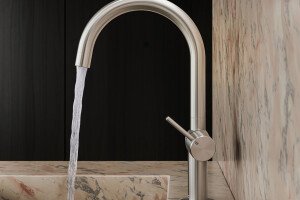This composite residential house consists of a ground floor based on a concrete piloti and a second floor based on a grid composition plan. The ground floor is an open space, which doubles as a parking lot, while the second floor makes up the main living space. At the ground level, open space is secured to the utmost. The piloti space offers substantial room for two cars, while exhibiting a semi-public appearance. The remaining space aside from the piloti has fruit trees planted, colored by flowering plants and a vegetable garden. Within the site, an awareness of being connected to or isolated from the city area sparks between the residents and the city environment. The second floor consists of twelve cells, each the size of four and a half tatami mats. The four central cells represent free space, forming a tatami-laid hallway. This multi-purpose room allows for various living landscapes. Aside from everyday family life, it serves as a place for enjoying the extraordinary moments, such as dinner parties with friends, birthday parties, mom parties, for children to do homework together, craft workshops and so on. While being a comfortable space for everyday family life, its urban appearance also reflects individual people’s activities and tastes.
Plane composition An orderly grid arises on the upper level, laying out twelve cells of four and a half mats, and making up 13 cells including the terrace. After passing through the stairway and the doma, the hallway is arranged at the centre. The living area mainly crosses through this space to the rooms on the right and left. In the central hallway, a low table is installed, with the line of movement of everyday life secured around it. This mechanism requires that one passes through the hallway anytime he moves from one room to another. While the grid is neat, it doesn’t suppress everyday functions, and offers a quantity of various living areas. It expresses both rules and irregularities, abstraction and concreteness.
Spatial flexibility The living space doesn’t have many functional limitations, aside from the wet area. The daily activity is formed between the tatami hallway and rooms on both sides, and remains within an indistinct living area, which puts no limits on functionality. Children doing homework separately at the low table or the dining table, dinner held at the dining table or at the low table, sleeping in individual bedrooms or in the hallway beside each other – various actions of the family can be spontaneously realized.
Materials Five sun square (150 mmsq) pillars, ridge beams, and gable beams, are all made of domestic Japanese cedar. At the face side of timber joints, priority is given to carpenter hand work over precut. The tatami made of Kumamoto soft rush, the timber and finishing materials of cedar from Akita and Niigata and sawara conifer from Kiso, the whole building utilizes materials from neighbouring prefectures, excluding the use of imported timber. The application of domestic timber as a constructional and finishing material combines with the perspective of leading to the vitalization of domestic forestry. With classical carpenter craftsmanship, making the most out of powerful, domestically produced finishing materials, close attention is paid to knowledge of materials and aesthetic sense in proportion.
Fittings The tatami-laid hallway has a doorway to each of the rooms; in order from the back - the living room, kitchen, and sanitary. Every doorway utilizes various-sized fittings, which are all made of Japanese cedar. Opening and closing the fittings according to function and purpose forms the size of the space, while creating various living areas. From a small bedroom or a middle-sized setting to a large multipurpose space, wooden fittings play a great role in creating a living space.
Exterior Located in the vicinity of the Sea of Japan, it is exposed to strong winds for a half year during the winter months. The structure is firmly held by the first floor made of reinforced concrete with extra wall quantity, assuming the seismic force as well as the wind pressure. The wooden structure is placed at the top, and porcelain tiles are applied as a measure to protect against deterioration of the exterior walls by the sea breeze. The result is an expression of proportion due to the reinforced concrete and porcelain tiles.





























